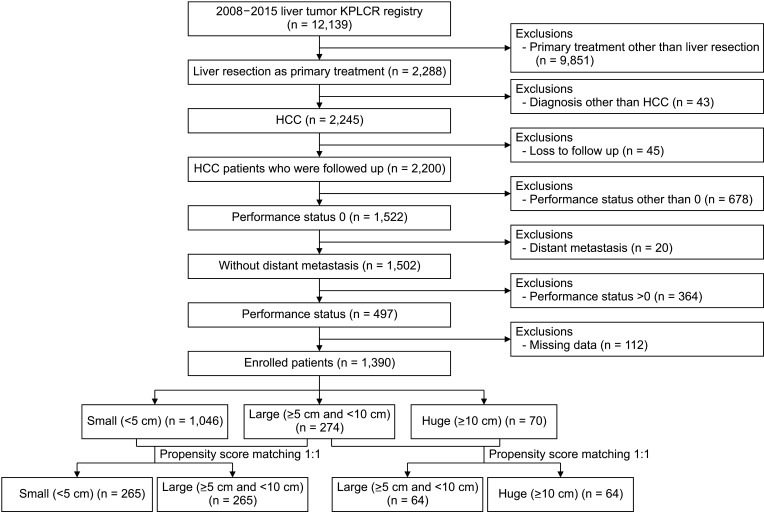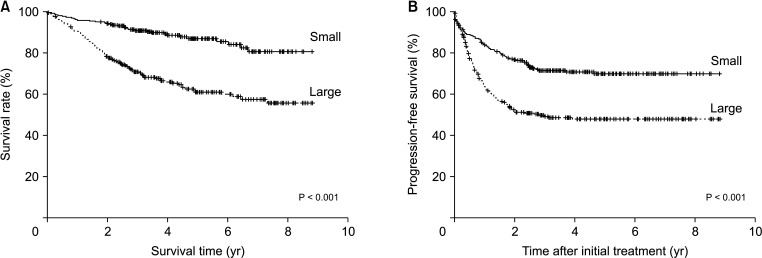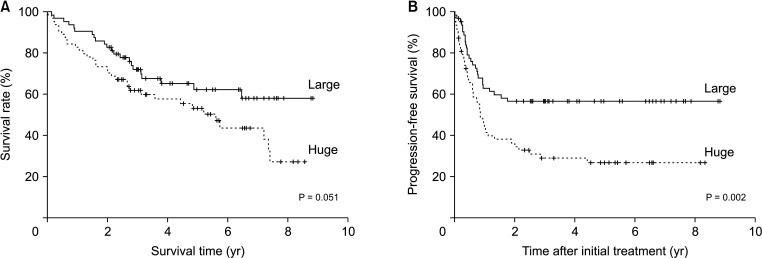Ann Surg Treat Res.
2022 Apr;102(4):193-204. 10.4174/astr.2022.102.4.193.
Impact of tumor size on hepatectomy outcomes in hepatocellular carcinoma: a nationwide propensity score matching analysis
- Affiliations
-
- 1Department of Surgery, Seoul National University College of Medicine, Seoul, Korea
- KMID: 2527836
- DOI: http://doi.org/10.4174/astr.2022.102.4.193
Abstract
- Purpose
The aim of this study was to compare surgical outcomes after liver resection for hepatocellular carcinoma (HCC) according to tumor size using a large, nationwide cancer registry-based cohort and propensity score matching.
Methods
From 2008 to 2015, a total of 12,139 patients were diagnosed with liver cancer and registered in the Korean Primary Liver Cancer Registry. Patients without distant metastasis who underwent hepatectomy as a primary treatment were selected. We performed 1:1 propensity score matching between the small (<5 cm), large (≥5 cm and <10 cm), and huge (≥10 cm) groups.
Results
Overall, 265 patients in the small and large groups were compared, and 64 patients each in the large and huge groups were compared. The overall and progression-free survival rates were significantly lower in the large group than in the small group (P < 0.001 and P < 0.001, respectively). Overall survival tended to be poorer in the huge group than in the large group (P = 0.051). The progression-free survival rate was significantly lower in the huge group than in the large group (P = 0.002).
Conclusion
Although primary liver resection can be considered even in patients with huge HCC, greater caution with careful screening for recurrence is needed.
Figure
Cited by 2 articles
-
Comparing efficacies of different treatment regimens in patients with hepatocellular carcinoma accompanied by portal vein tumor thrombus using network meta-analysis
Seungji Lee, Sung Kyu Song, Byungje Bae, Yongkeun Park
Ann Surg Treat Res. 2022;103(5):280-289. doi: 10.4174/astr.2022.103.5.280.Prognostic value of preoperative protein-induced vitamin K absence or antagonist II after liver resection for hepatitis B-related hepatocellular carcinoma: a nationwide multicenter study
Dahn Byun, Seul Gi Lee, Hyeyoung Kim, Yunghun You, Jaehag Jung, Je Ho Jang, Moon-Soo Lee, Chang-Nam Kim, Byung Sun Cho, Yoon-Jung Kang,
Ann Surg Treat Res. 2022;103(5):271-279. doi: 10.4174/astr.2022.103.5.271.
Reference
-
1. Lang H, Sotiropoulos GC, Dömland M, Frühauf NR, Paul A, Hüsing J, et al. Liver resection for hepatocellular carcinoma in non-cirrhotic liver without underlying viral hepatitis. Br J Surg. 2005; 92:198–202. PMID: 15609381.
Article2. Capussotti L, Muratore A, Massucco P, Ferrero A, Polastri R, Bouzari H. Major liver resections for hepatocellular carcinoma on cirrhosis: early and long-term outcomes. Liver Transpl. 2004; 10(2 Suppl 1):S64–S68. PMID: 14762842.
Article3. Poon RT, Fan ST, Lo CM, Ng IO, Liu CL, Lam CM, et al. Improving survival results after resection of hepatocellular carcinoma: a prospective study of 377 patients over 10 years. Ann Surg. 2001; 234:63–70. PMID: 11420484.
Article4. Korean Liver Cancer Association. National Cancer Center. 2018 Korean Liver Cancer Association-National Cancer Center Korea Practice Guidelines for the management of hepatocellular carcinoma. Gut Liver. 2019; 13:227–299. PMID: 31060120.5. Andreou A, Vauthey JN, Cherqui D, Zimmitti G, Ribero D, Truty MJ, et al. Improved long-term survival after major resection for hepatocellular carcinoma: a multicenter analysis based on a new definition of major hepatectomy. J Gastrointest Surg. 2013; 17:66–77. PMID: 22948836.
Article6. Huang J, Zhang Y, Peng Z, Gao H, Xu L, Jiao LR, et al. A modified TNM-7 staging system to better predict the survival in patients with hepatocellular carcinoma after hepatectomy. J Cancer Res Clin Oncol. 2013; 139:1709–1719. PMID: 23982274.
Article7. Torzilli G, Belghiti J, Kokudo N, Takayama T, Capussotti L, Nuzzo G, et al. A snapshot of the effective indications and results of surgery for hepatocellular carcinoma in tertiary referral centers: is it adherent to the EASL/AASLD recommendations?: an observational study of the HCC East-West study group. Ann Surg. 2013; 257:929–937. PMID: 23426336.
Article8. Lee EC, Kim SH, Park H, Lee SD, Lee SA, Park SJ. Survival analysis after liver resection for hepatocellular carcinoma: a consecutive cohort of 1002 patients. J Gastroenterol Hepatol. 2017; 32:1055–1063. PMID: 27797420.
Article9. Goh BK, Chow PK, Teo JY, Wong JS, Chan CY, Cheow PC, et al. Number of nodules, Child-Pugh status, margin positivity, and microvascular invasion, but not tumor size, are prognostic factors of survival after liver resection for multifocal hepatocellular carcinoma. J Gastrointest Surg. 2014; 18:1477–1485. PMID: 24855028.
Article10. Minagawa M, Ikai I, Matsuyama Y, Yamaoka Y, Makuuchi M. Staging of hepatocellular carcinoma: assessment of the Japanese TNM and AJCC/UICC TNM systems in a cohort of 13,772 patients in Japan. Ann Surg. 2007; 245:909–922. PMID: 17522517.11. Hwang S, Lee YJ, Kim KH, Ahn CS, Moon DB, Ha TY, et al. Long-term outcome after resection of huge hepatocellular carcinoma ≥ 10 cm: single-institution experience with 471 patients. World J Surg. 2015; 39:2519–2528. PMID: 26126423.
Article12. Zhang H, Yuan SX, Dai SY, Zhang JM, Huang X, Lu CD, et al. Tumor size does not independently affect long-term survival after curative resection of solitary hepatocellular carcinoma without macroscopic vascular invasion. World J Surg. 2014; 38:947–957. PMID: 24258262.
Article13. Zhou YM, Li B, Xu DH, Yang JM. Safety and efficacy of partial hepatectomy for huge (≥10 cm) hepatocellular carcinoma: a systematic review. Med Sci Monit. 2011; 17:RA76–RA83. PMID: 21358616.
Article14. Wakayama K, Kamiyama T, Yokoo H, Orimo T, Shimada S, Einama T, et al. Huge hepatocellular carcinoma greater than 10 cm in diameter worsens prognosis by causing distant recurrence after curative resection. J Surg Oncol. 2017; 115:324–329. PMID: 28192617.
Article15. Ettorre GM, Levi Sandri GB, Colasanti M, Mascianà G, de Werra E, Santoro R, et al. Liver resection for hepatocellular carcinoma ≥5 cm. Transl Gastroenterol Hepatol. 2017; 2:22. PMID: 28447057.
Article16. Noh JH, Kim TS, Ahn KS, Kim YH, Kang KJ. Prognostic factors after hepatic resection for the single hepatocellular carcinoma larger than 5 cm. Ann Surg Treat Res. 2016; 91:104–111. PMID: 27617250.
Article17. Allemann P, Demartines N, Bouzourene H, Tempia A, Halkic N. Long-term outcome after liver resection for hepatocellular carcinoma larger than 10 cm. World J Surg. 2013; 37:452–458. PMID: 23188527.
Article18. AJCC. AJCC cancer staging manual. 8th ed. Updates and corrections [Internet]. New York: Springer;2017. cited 2021 Sep 30. Available from: www.cancerstaging.org .19. Yoon JS, Lee HA, Kim HY, Sinn DH, Lee DH, Hong SK, et al. Hepatocellular carcinoma in Korea: an analysis of the 2015 Korean Nationwide Cancer Registry. J Liver Cancer. 2021; 21:58–68.
Article20. Chen JH, Wei CK, Lee CH, Chang CM, Hsu TW, Yin WY. The safety and adequacy of resection on hepatocellular carcinoma larger than 10 cm: a retrospective study over 10 years. Ann Med Surg (Lond). 2015; 4:193–199. PMID: 26052436.
Article21. Toro A, Ardiri A, Mannino M, Arcerito MC, Mannino G, Palermo F, et al. Effect of pre- and post-treatment α-fetoprotein levels and tumor size on survival of patients with hepatocellular carcinoma treated by resection, transarterial chemoembolization or radiofrequency ablation: a retrospective study. BMC Surg. 2014; 14:40. PMID: 24993566.
Article22. Bai DS, Zhang C, Chen P, Jin SJ, Jiang GQ. The prognostic correlation of AFP level at diagnosis with pathological grade, progression, and survival of patients with hepatocellular carcinoma. Sci Rep. 2017; 7:12870. PMID: 28993684.
Article23. Wang G, Lu X, Du Q, Zhang G, Wang D, Wang Q, et al. Diagnostic value of the γ-glutamyltransferase and alanine transaminase ratio, alpha-fetoprotein, and protein induced by vitamin K absence or antagonist II in hepatitis B virus-related hepatocellular carcinoma. Sci Rep. 2020; 10:13519. PMID: 32782270.
Article24. Si YQ, Wang XQ, Fan G, Wang CY, Zheng YW, Song X, et al. Value of AFP and PIVKA-II in diagnosis of HBV-related hepatocellular carcinoma and prediction of vascular invasion and tumor differentiation. Infect Agent Cancer. 2020; 15:70. PMID: 33292429.
Article25. Bağırsakçı E, Şahin E, Atabey N, Erdal E, Guerra V, Carr BI. Role of albumin in growth inhibition in hepatocellular carcinoma. Oncology. 2017; 93:136–142. PMID: 28486226.
Article26. Carr BI, Guerra V. Serum albumin levels in relation to tumor parameters in hepatocellular carcinoma patients. Int J Biol Markers. 2017; 32:e391–e396. PMID: 28862714.
Article27. Tarao K, Rino Y, Ohkawa S, Tamai S, Miyakawa K, Takakura H, et al. Close association between high serum alanine aminotransferase levels and multicentric hepatocarcinogenesis in patients with hepatitis C virus-associated cirrhosis. Cancer. 2002; 94:1787–1795. PMID: 11920542.
Article28. Fung J, Cheung KS, Wong DK, Mak LY, To WP, Seto WK, et al. Long-term outcomes and predictive scores for hepatocellular carcinoma and hepatitis B surface antigen seroclearance after hepatitis B e-antigen seroclearance. Hepatology. 2018; 68:462–472. PMID: 29534307.
Article
- Full Text Links
- Actions
-
Cited
- CITED
-
- Close
- Share
- Similar articles
-
- Impact of clinically significant portal hypertension on surgical outcomes for hepatocellular carcinoma in patients with compensated liver cirrhosis: a propensity score matching analysis
- Laparoscopic hepatectomy versus open hepatectomy for hepatocellular carcinoma: A propensity case-matched analysis of the long-term survival
- Safety of nighttime elective hepatectomy for hepatocellular carcinoma patients: a retrospective study
- Staged partial hepatectomy versus transarterial chemoembolization for the treatment of spontaneous hepatocellular carcinoma rupture: a multicenter analysis in Korea
- Prognostic Significance of Preoperative Controlling Nutritional Status Score in Patients Who Underwent Hepatic Resection for Hepatocellular Carcinoma




